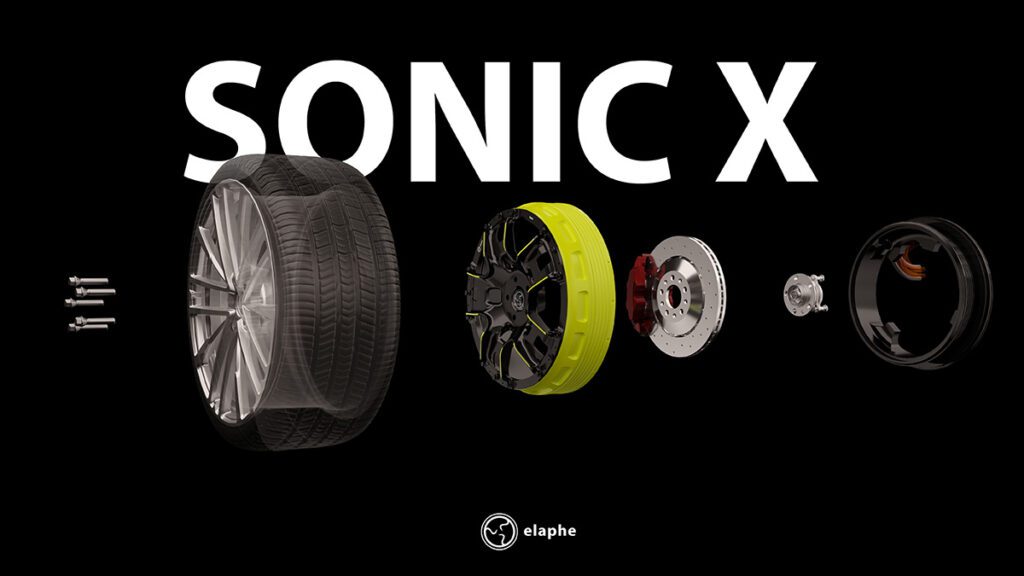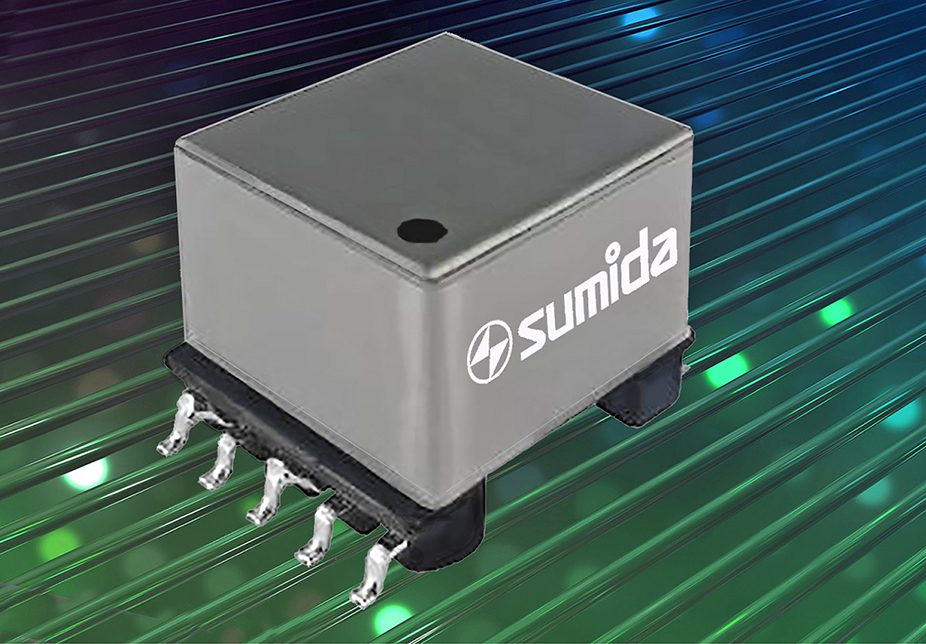In the short history of the modern EV industry, it’s been common for automakers to launch plug-in cars under a new brand or model – particularly those companies who are serious about selling EVs at scale. Or, at least the ones that want to appear serious about selling a lot of EVs.
Even though Hyundai is a few years late to the EV party, its new Ioniq can claim a few milestones. It’s the first vehicle to offer three distinct drivetrain options – hybrid, plug-in hybrid and all-electric. Also, the Ioniq Hybrid and Ioniq Electric are the most fuel-efficient vehicles in their class, no small feat of engineering (the Ioniq Plug-in Hybrid has not yet been given an official EPA rating).
The Ioniq Hybrid Blue is EPA-rated at 58 MPG combined, beating the Prius Eco’s 56 MPG. The Ioniq Electric is EPA-rated at 136 MPGe, making it the most efficient EV on the market. The next best efficiency ratings are held by the Prius Prime (133 MPGe in electric mode) and the BMW i3 (124 MPGe).
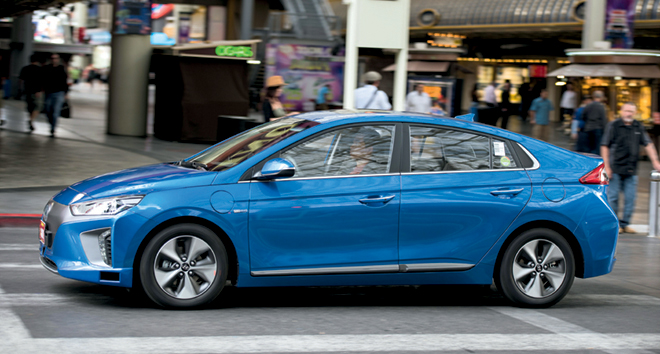
While it’s clear that traditional hybrid shoppers are largely driven by overall fuel efficiency ratings, the conversation about plug-in vehicles usually starts and ends with electric range. In that category, the Ioniq Electric is far from the top of the list, offering 124 miles of range.
Hyundai is hoping that as more and more EV models become available, buyers will start shopping based on a vehicle’s overall value and efficiency and not solely its maximum range.
Just weeks after GM started deliveries of the Bolt EV with its 238-mile range and 119 MPGe, starting at $36,620, will the Ioniq Electric turn the heads of any EV buyers? Its 124-mile range is a lot shorter, but its 136 MPGe efficiency rating can’t be beat, and its $29,500 MSRP is more than $7,000 lower.
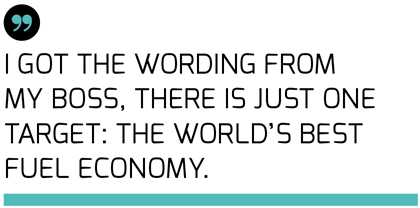
Efficiency mandate
At the Ioniq launch event, Hyundai executives explained that this development project started about 12 years ago. Back in 2005, as Toyota was making a lot of headlines one year into deliveries of its second-generation Prius, Hyundai’s top brass handed the company’s product development team a new directive.
Glenn Kim, leader of Hyundai’s eco-technology system performance development team described the company’s goals.
Glenn Kim: For this project, Ioniq, we didn’t have numbers as a target. I got the wording from my boss, there is just one target: The world’s best fuel economy. Even though we didn’t know our competitors future numbers of new cars. So, if competitors achieve some such number, you have to overcome that. [If they achieve] 52 mpg, we need more than 52. [If they achieve] 55, more than 55.
To engineer what they called “mission impossible,” Hyundai says it changed or enhanced many of its typical vehicle systems. The hardest part about upping efficiency is doing so without making the vehicle drive like a slug. To maintain drivability, engineers designed a dedicated version of the engine for the hybrid and PHEV models, and used a dual-clutch transmission for the first time with an electric motor. Of course, Hyundai also invested heavily in battery development.
Lead-acid-less
One of the most interesting engineering choices for all three Ioniq vehicles was the decision to use lithium-ion cells for the 12 V system in the Ioniq Hybrid. The company calls it the consolidated 12 V battery, and it’s the first time we’ve seen a production vehicle of any type that doesn’t use a traditional lead-acid battery to power the low-voltage circuits. Even cars with the largest and most advanced Li-ion battery packs – including the latest versions of Model S, Prius and Bolt EV – still use lead-acid batteries. These ancient battery chemistries are dirt cheap, and pretty good at what they do. All the existing auxiliary 12 V systems have been designed to work well with lead-acid, so electrification engineers have opted to continue using them. In fact, Hyundai only decided to use Li-ion cells for the Ioniq Hybrid, and continues to use lead-acid in the Ioniq PHEV and Ioniq Electric.
For the hybrid, the math worked out differently. When you have a directive to be the best in efficiency for a gasoline hybrid, shedding those extra pounds of lead proved to make the most sense. Hyundai says that by using Li-ion cells for the 12 V loads, it could eliminate a 50 Ah AGM battery, remove 26 pounds from the vehicle, and improve cargo capacity by 2.4%.
The low-voltage Li-ion pack sits directly adjacent to the high-voltage traction battery, although the two are electrically isolated. The vehicle also has a 12 V Battery Reset button to the left of the steering wheel that the designers describe as a self-jump start function. When the car is turned off, the high-voltage battery is disconnected, and it’s possible to fully discharge the 12 V battery – by leaving the headlamps on, for example. The self-jump start button will use a tiny amount of energy to open a relay and allow the traction battery to recharge the 12 V system so the car can start again.
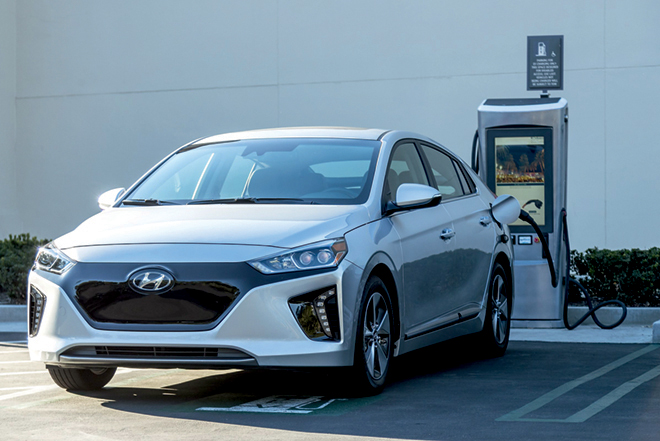
Changing the EV range conversation
With the world’s leading gas mileage, the Ioniq Hybrid makes a straightforward sales pitch to efficiency-conscious car buyers. However, given the Ioniq Electric’s specifications – with just 124 miles of range – it’s no surprise that the company is making the hard sell based on value for the money and efficiency (although company reps did tell us that Hyundai also has higher-range EVs in the pipeline).
“We actually intend to have a longer-range EV,” said Michael O’Brien, Hyundai’s Vice President of Product Planning. “We have one planned. The big problem is it will not be as efficient.”
O’Brien argued that it is relatively easy to engineer more. “It’s easy to put a bigger engine in, it’s easier to put more space in. It’s really, really difficult to make more efficiency,” he said. “That’s the biggest challenge of engineers. How do you make things more efficient and still do everything customers want?”
The potential problem for the Ioniq Electric is that EV customers might want more range, in spite of the fact that very few need it. Regular Charged readers are familiar with the statistics about how far the average person drives each day, and it’s a lot less than the Ioniq Electric’s 124-mile range.
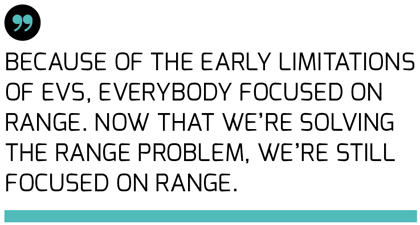
However, with the launch of the Chevrolet Bolt EV and Tesla Model 3 this year, the auto industry has framed success for EVs as a race towards 200 miles or more for $30,000 or less. O’Brien says it’s time for automakers, the press and EV enthusiasts to change the conversation.
Michael O’Brien: I believe vehicle manufacturers have to do a much better job at representing efficiency in the EV area. Of course, because of the early limitations of EVs, everybody focused on range. Now that we’re solving the range problem, we’re still focused on range.
98% [of people] drive less than 100 miles [per day], and that’s intended driving, that’s not the actual driving. The actual driving is actually much less than that. So we’re talking about what people think they might do and their intentions. Our job is to help inform people that there are choices, and to make efficiency a bigger part of their informed decision.
Hyundai suggests a few different metrics to convey to customers that efficiency is important, including operating costs, upfront purchase price, and, of course, greenhouse gas reduction.
Explaining exactly how MPGe affects your wallet might be the best pitch to sway shoppers, and the Ioniq Electric has the numbers on its side. Because it uses the energy stored in the battery pack so efficiently, the Ioniq Electric has the lowest operating cost of any vehicle in the world – its EPA-estimated cost to drive 25 miles is just $0.81. The average new car costs about $2.24 to drive 25 miles, hybrids like the Prius and Ioniq Hybrid cost about $1.00, and the Chevy Bolt costs $0.92.
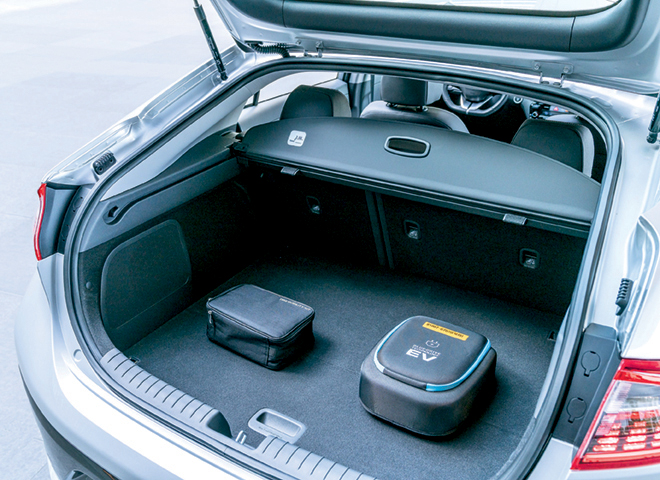
The Bolt has over 100 miles more range than the Ioniq Electric because it carries a lot more expensive batteries around, which decreases overall efficiency and accounts for the $7,000 price differential. John Shon, Hyundai’s Senior Manager for Product Planning, attempted to put that price premium in perspective.
John Shon: Value for the money is a space that Hyundai really owns, and customers have come to expect a very strong value proposition from us. Ioniq certainly doesn’t disappoint.
If you look at Ioniq Hybrid’s starting MSRP of $22,200, that’s more than 10% less than the starting price of a Prius. Even when you get all the bells and whistles, it comes out to $30,500, and that has more content than what’s available on the Prius.
For the Ionic Electric, with a starting MSRP of $29,500, when you factor in the $7,500 federal tax credit – and in the state of California you get a $2,500 clean vehicle rebate – the effective price is $19,500.
Much like horsepower, or the number of cylinders, or even towing capacity, some people do require a higher [range] figure. The question is how much are customers willing to pay for that convenience? Chevrolet Bolt is a great car, but if you look at just the MSRP of the Ioniq Electric versus the Chevy Bolt, you’re looking at a $7,000 price difference. That’s critical, because if you look at the average transaction price for a compact car, it’s in the high teens to low twenties. The Bolt, at $7,000 more, is outside the affordability of a lot of compact car buyers. So, what we’re hoping to do with Ionic Electric is make it more accessible to a majority of compact car buyers.
Just to give you a little bit of reference about what $7,000 means, if you look at the Hyundai sedan models from Accent to Sonata, that’s a two-class jump, and that price jump is less than $7,000. That’s just something we hope [the press] is cognizant of and we hope customers are cognizant of when they’re shopping EVs.
For the instances where you do have to travel extended distances, we offer standard DC fast charging on Ioniq Electric. And you see a proliferation of fast charging, especially DC fast charging networks, along the coasts of the US.
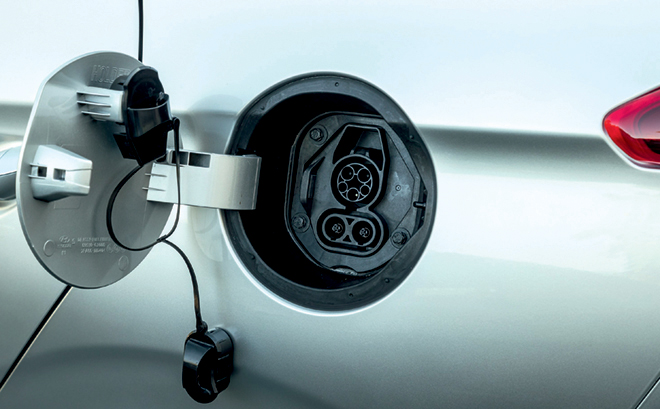
Faster DC charging
Every Ioniq Electric will come equipped with DC fast charging hardware, and it’s the first EV in the US capable of charging at power levels up to 100 kW with the CCS standard. At the moment, essentially every CCS-capable fast charger that’s installed in North America tops out at 50 kW or lower, but Hyundai, ChargePoint, and other networks and equipment manufacturers ensure us that higher power chargers will start to roll out “very soon.”
For DC fast chargers, the terms 100 kW and 50 kW represent the peak charging power – not sustained or average power. During a charging session, the batteries can only safely accept the peak recharge power for a short amount of time without being damaged. So, doubling the peak power does not cut the charge time in half.
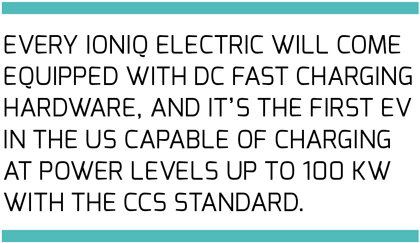
Hyundai says the Ioniq Electric will add 99 miles of range, or 80% of the battery pack’s capacity, in 30 minutes using a 50 kW charger, and in 23 minutes using 100 kW hardware.
Vision of an electric future
The combination of 124 miles of range and 100 kW charging in an affordable sedan is clearly a great EV value that fits the needs of most every commuter. However, it’s quite likely that Hyundai will have a tough time convincing the current car buying population to get over its natural inclinations and max EV-range obsessions.
The good news for fans of electrification is that there is a coming shift among consumers with buying power, and it’s trending towards EVs. Hyundai’s research shows that by 2020, millennials will pass the baby boomer generation and become the largest single buyers of new light vehicles in the US. When you survey the attributes that millennial buyers are looking for, you’ll see that manufacturers that offer EVs elicit significantly more interest.
In general, the younger generation has a more favorable view of hybrids, PHEVs and EVs, and they like urbanization – which Hyundai thinks “will support the sale of more electric vehicles moving forward.” 62% of millennials prefer to live in an urban environment, a much higher proportion than the previous few generations. That fact is predicted to drive sales of vehicles with different attributes than those favored by consumers who live outside cities and are used to driving much longer distances.
While it’s great to hear that Hyundai’s data predicts a future more favorable to EVs, there is still one lingering question: How many buyers will see the value in the Ioniq Electric, today?
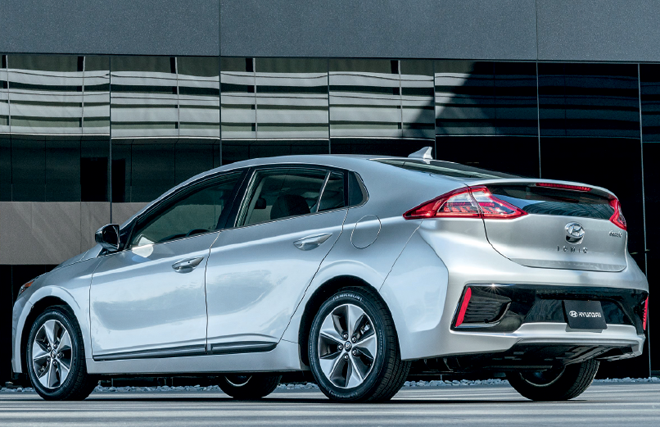
Availability
The Ioniq Hybrid started to trickle into dealerships nationwide in February, and the Ioniq PHEV will be out in the fourth quarter of this year. The Ioniq Electric will start retail sales in April, initially in California, then in the nine other states that follow its zero-emission vehicle rules. Hyundai said that every one of its dealers will have the ability to order the EV at a customer’s request. But without vehicles on the lot and a sales staff actively promoting them, it’s safe to assume that Ioniq Electric sales outside of the ten ZEV states will be rare.
This article originally appeared in Charged Issue 30 – March/April 2017 – Subscribe now.







































